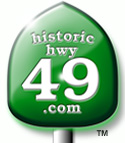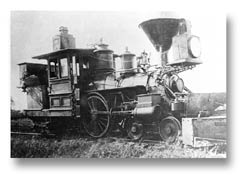                  
|

There
is evidence to suggest man's presence in the Auburn
area dating back to 1400 B.C. However, the first
known people were the Nisenan, an offshoot of the
Maidu Tribe. There is documentation of well
established villages in Auburn. The Nisenan, living
in the midst of what would become the heart of the
Gold Rush, were eventually pushed out of their land
within two to three years of the discovery of Gold
in Coloma, a Nisenan village called
"Cullomain."
 It
wasn't until the 1840's that the first
Euro-American settlers, hunters, trappers and fur
traders appeared in the Ravine. They were soon
followed by explorer/surveyor John Fremont in 1843
- 44, John Bidwell in 1844 - 45 and Theodore Sigard
in 1845. As the first settlers started appearing in
the early wagon trains, a young Frenchman named
Claude Chana came west settling in at Sigard's
Ranch on the Bear River. It
wasn't until the 1840's that the first
Euro-American settlers, hunters, trappers and fur
traders appeared in the Ravine. They were soon
followed by explorer/surveyor John Fremont in 1843
- 44, John Bidwell in 1844 - 45 and Theodore Sigard
in 1845. As the first settlers started appearing in
the early wagon trains, a young Frenchman named
Claude Chana came west settling in at Sigard's
Ranch on the Bear River.

Chana, still at Sigard's
Ranch, learned of Marshall's discovery at the
Sawmill in Coloma and set out with a party to try
his luck. On May 16, 1848 Claude Chana found gold
in the Auburn Ravine. By April 1849 North Fork Dry
Diggings had become a well established mining camp.
The camp went by many names including Rich Ravine
and Wood's Dry Diggings of Auburn Ravine. In August
of 1849 the camp was officially named Auburn.
Because Auburn was just a wagon trip from
Sacramento, centrally located in the gold country
and just below the snow line it became known as the
"Jumping off" spot for the miners. However, it was
on May 13, 1865 when the Central Pacific Railroad
officially made Auburn one of its stops that Auburn
truly became a city. By the turn of the century the
population of Auburn was a little more than
2,000.
|



 It
wasn't until the 1840's that the first
Euro-American settlers, hunters, trappers and fur
traders appeared in the Ravine. They were soon
followed by explorer/surveyor John Fremont in 1843
- 44, John Bidwell in 1844 - 45 and Theodore Sigard
in 1845. As the first settlers started appearing in
the early wagon trains, a young Frenchman named
Claude Chana came west settling in at Sigard's
Ranch on the Bear River.
It
wasn't until the 1840's that the first
Euro-American settlers, hunters, trappers and fur
traders appeared in the Ravine. They were soon
followed by explorer/surveyor John Fremont in 1843
- 44, John Bidwell in 1844 - 45 and Theodore Sigard
in 1845. As the first settlers started appearing in
the early wagon trains, a young Frenchman named
Claude Chana came west settling in at Sigard's
Ranch on the Bear River.